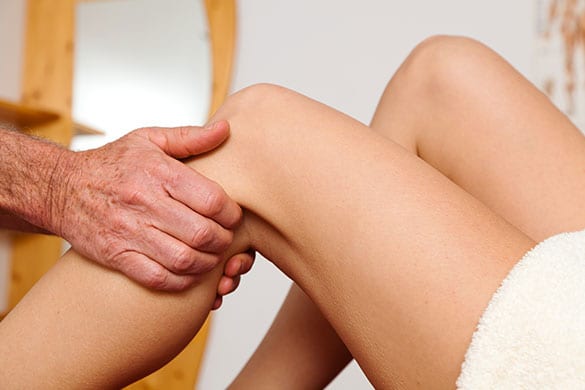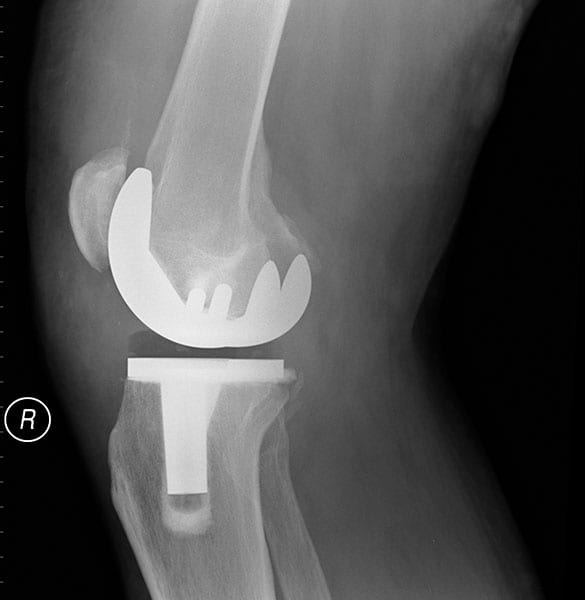
A knee specialist in Los Angeles can get you moving again.
The largest joint in the human body, the knee is susceptible to injury due to its prominent location and constant use. Each of the structures that make up the knee have the potential to be a source of some degree of discomfort, instability, or limited range of movement. The knee itself is where the thighbone, shinbone, and kneecap meet. Common knee problems that may require attention from a knee specialist in Los Angeles could involve issues with any of the bones, along with:
- Supporting articular and meniscal cartilage
- Tendons
- Collateral and cruciate ligaments
CONTACT US TODAY
Fractures
The kneecap (patella) is the most likely bone in the knee area to become fractured, or broken. A hard impact or bones weakened from degenerative arthritis may also contribute to a fractured femur or tibia at the point these bones form the knee. Bracing, splinting, and surgery to re-position bones that are misaligned are among the treatments for fractures a knee specialist in Los Angeles may recommend.
Dislocation
An unstable kneecap or an injury may result in a dislocation, which occurs when a bone slips out of place. The extent of the dislocation will depend on what areas are affected. If the tibia and femur become misaligned from a hard impact like what might happen with a sports-related injury or a slip-and-fall accident, for instance, the kneecap may also be affected. It’s usually high-impacts that cause one or more of the bones of the knee to slip out of place. While some dislocated bones may naturally go back into the correct positions, ligaments and tendons may still be damaged enough to require treatment from a knee specialist.


ACL (Anterior Cruciate Ligament) Injuries
Athletes involved in high-energy sports like football, baseball, and soccer are more likely to experience ACL injuries. The anterior cruciate ligament may also become damaged from a sudden or excessive twist or turn. A knee specialist in Los Angeles usually makes a positive diagnosis of an ACL injury with a comparison of the affected knee to the unaffected one, a review of symptoms that may include tenderness and swelling around the knee, and testing that includes an X-ray, MRI scan, or ultrasound. If rest, ice, compression, and elevation aren’t effective, bracing, the use of crutches to take weight off of the affected knee, and exercises may be recommended. Surgery for an ACL injury usually involves replacing the damaged ligament with a segment of tendon tissue.
PCL (Posterior Cruciate Ligament) Injuries
A severe impact to the front of the knee while it’s bent may be enough to cause a PCL injury. As is the case with ACL injuries, PCL damage is often associated with sports-related injuries. Despite being stronger and larger than the anterior cruciate ligament, the PCL can still become torn. A knee specialist in Los Angeles will base treatment suggestions based on how the injury is classified. A grade I tear is a partial tear. If the ligament is loose and partially torn, it’s grade II. A grade III injury is a complete PCL tear. A grade IV PCL injury involves damage to the PCL and other ligaments. Treatment options include temporary bracing, exercises to strengthen supporting thigh muscles, NSAIDs, and surgery to repair or replace the ligament.
Meniscal Tears
A meniscal tear can occur with any sport, activity, or movement that involves twisting, pivoting, or the risk of a severe impact. A tear may also occur if this rubbery, C-shaped disc has been damaged from age-related wear or an underlying health issue. Meniscus tears can be mild, moderate, or severe. If the tear is severe, the affected knee may become wobbly or constantly feel like it’s going to give way. It’s at this point that patents are often referred to a knee specialist to explore conservative and surgical treatment options.
Tendon Tears
Symptoms that become increasingly noticeable during daily movements may be a sign of torn patellar or quadriceps tendons. In addition to helping patients identify possible risk factors to prevent further injury, a knee specialist might also recommend physical therapy techniques. Options may include the use of a patellar tendon strap to redistribute force, iontophoresis with corticosteroid medicine delivered through the skin with a mild electrical charge, or stretching and strengthening exercises.
A knee specialist in Los Angeles can also provide advice on how to prevent knee injuries or reduce the risk of experiencing the same problem again following treatment. The most effective knee injury prevention plan typically involves a combination of knowing physical limits, knowing when to rest or modify activities to allow tissues to heal, and making smart decisions with diet and exercise habits. It also helps when patients know what makes their knees more likely to become stressed, injured, or irritated. For instance, if impact-oriented exercises frequently result in pain, a knee specialist may recommend elliptical training or water-based exercises as an alternative.




